More about Thimbles





Magdalena and William Isbister.
The terms exposition and exhibition have come to be used synonymously although exposition seems to be the term more commonly used in France and the United States of America and exhibition seems to be the term usually used in England and Germany. Exposition literally means an exhibition with broad coverage and large scale and substantial content although there do not seem to be any limits set up to actually regulate the use of the two terms,
Expositions became known as public fairs or displays of industrial and artistic productions, designed usually to promote trade and to reflect cultural progress. Expositions grew out of the traditional medieval cloth fairs.
The first world fair seems to have been held in London in 1756 and was sponsored by the Society of Arts which itself was founded just two years previously. According to the Bureau of International Expositions (BIE), which sanctions every world exposition, the first ‘World Exposition’ or ‘Expo’ was the ‘The Great Exhibition’, held at the Crystal Palace in London in 1851. Since this time many expositions and fairs have been held all over the world.
Whilst it may be difficult to determine the difference between exposition and exhibition it is equally difficult, in thimble parlance, to differentiate between a souvenir and a commemorative thimble. Clearly some thimbles were made to commemorate a particular event but they may also have been sold as souvenirs of the event, at the event.


Fig 1
A good example of this are the thimbles finished by Simons’ thimble makers at the World's Columbian Exposition in Chicago in 1893 (Fig 1). The thimbles were clearly commemorative of the exposition but they were sold at the Simons’ exhibit upon completion.
In this paper we propose to describe ‘exposition thimbles’ from Europe, we will not attempt to differentiate between commemorative or souvenir thimbles, and will not further address ‘American exposition thimbles’ as they have been more than admirably described already by Rodgers (1).
Since the first world fair there have been many fairs in many countries but we have only been able to identify nine fairs in Europe for which either souvenir or commemorative thimbles were produced.
The British Isles and Ireland
‘The Great Exhibition of the Works of Industry of all Nations’ or Great Exhibition (Crystal Palace Exhibition)
The Great Exhibition of the Works of Industry of all Nations was held in Hyde Park, London from 1 May to 15 October 1851 in a specially constructed glass and cast iron building. It became known as the Crystal Palace. The building was designed by Joseph Caxton and was based on his experience of constructing greenhouses (Fig 2). The Great Exhibition was the first of a series of World Exhibitions of industry and culture to come under the auspices of the BIE. Prince Albert helped to organize and promote the exhibition and it was a celebration of industrial design and technology from all over the commonwealth and the rest of the world. There were over 13,000 exhibits and approximately 6,200,000 visitors attended the exhibition (Fig 3).

Fig 2

Fig 3
Several thimbles were made to commemorate the exhibition. In particular Alfred Taylor of Great Howard Street, Birmingham registered (design number 73871) a design which shows the Crystal Palace (Fig 2) and has the text ‘Exhibition of All Nations 1851’ above the pictorial border. The thimble bears the diamond registration mark and from this and the registration document the name of the maker can be ascertained (2). Taylor did not add his own registered mark to this thimble (Fig 4).

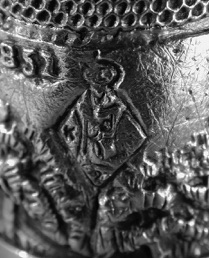
Fig 4


Fig 5
Another thimble commemorating the exhibition (Fig 5) has "Great Exhibition Hyde Park 1851” stamped on the rim. The maker is unknown.
After the exhibition closed the Crystal Palace was moved to Sydenham Hill in South London and another thimble was made to commemorate the move (Fig 6). In addition to an image of the Crystal Palace the rim is inscribed ‘Crystal Palace Sydenham’.

Fig 6
One further thimble may be associated with the Great Exhibition. The Ionian Islands were under the protection of the British Crown and the Governor, Lord Seaton, exhibited a thimble at the Great Exhibition in 1851. This thimble had a plain dimpled top with an applied border that depicted the arms of the seven islands of the Ionian group (Fig 7).


Fig 7
The company of Peyton and Iles exhibited various items at the exhibition and won a bronze medal although this medal was not for thimbles (3). On November 30th 1936 the Crystal Palace was destroyed by fire.
Great Industrial Exhibition 1853
The Great Industrial Exhibition of 1853 was held in Dublin, Ireland. It was the largest exhibition to have been held in Ireland and was funded by William Dargan, an engineer and ‘father of the Irish railways’. It was hoped that through the exhibition the industrial revolution could be brought to Ireland but the people of Ireland seemed not to be able to relate to much of the technology on display (overall attendance 1,156,232). The exhibition thus made a big financial loss and ruined Dargan. Visitors to the exhibition were more impressed by the building than the exhibits contained there in (Fig 8).

Fig 8
A thimble was made to commemorate this exhibition by an unknown maker. It depicted the exhibition building around the border and was imprinted ‘Dublin 1853’ on the rim (Fig 9).

Fig 9
The International of 1862, or Great London Exposition
The exhibition was held from May 1st to November 1st beside the Royal Horticultural Society Gardens in South Kensington, London. The main façade was along Cromwell Road (Fig 10) and like the 1851 exhibition celebrated industry, technology and the fine arts (Fig 11). The site is now occupied by the Natural History and Science Museums but little of the original building remains. Over six million people attended the exhibition and unlike the Dublin Exhibition the London exhibition made a good profit.

Fig 10 © Science & Society Picture Library

Fig 11
Charles Iles exhibited at the exhibition (3) where he showed hooks and eyes and enamel-lined thimbles. It is probable that he sold inexpensive souvenir thimbles too (Fig 12).



Fig 12 Fig 13 Fig 14
This souvenir set contained a silver cased thimble, complete with the Iles mark (Fig 13), and an ‘ivorine’ finger guard (Fig 14). Similar boxed sets were on sale in Sydney as late as 1907 (personal communication: Sue Gowan).
Two silver thimbles are associated with the 1862 exhibition (2). One was made by Henry Griffith of Birmingham although it does not bear his mark. The design (139132) was registered on the 26.3.1861. The thimble depicts the Cromwell Road façade (Fig 9) and bears the inscription ‘International Exhibition 1862’ (Fig 15). It does not bear the diamond mark but is the same as the thimble shown in the original design document.


Fig 15
The second thimble does bear a design diamond mark and corresponds to the design (143397) registered by George Cartwright and Horace Woodward of Birmingham on the 12.9.1861 (Fig 16). The border is decorated with an image of the exhibition hall, which seems more like the Crystal Palace than the Cromwell Road building, but bears the words ‘International Exhibition 1862’ around the rim.


Fig 16
It is not known whether either Griffith or Cartwright and Woodward had exhibits in the exhibition but clearly since the designs were registered in 1861 they planned to sell the thimbles as either souvenirs of the exhibition or as thimbles to commemorate the exhibition. It is interesting to note that these two thimbles depicting buildings were the only ‘building thimbles’ to have had their design registered.
The British Empire Exhibition 1924
The British Empire Exhibition was held at Wembley in 1924 and 1925. It was, as the name implied, a celebration of the British Empire. Of the 58 countries in the Empire only two, Gambia and Gibraltar failed to exhibit. About 27 million visitors attended the exhibition. Industry, engineering and the arts were the predominant themes of the pavilions. The Empire stadium became the Wembley stadium (Fig 17), which has only recently been replaced.

Fig 17
The days of silver, pictorial, commemorative exhibition thimbles had passed but Henry Griffith did make a simple silver thimble with the ‘Wembley Lion’ and ‘Wembley 1924’ on a ribbed band (Fig 18).


Fig 18
An unknown maker made a brass souvenir thimble which was sold in a suitably inscribed box at the exhibition (Fig 19). It is inscribed ‘British Empire Exhibition’ around a plain flat band.
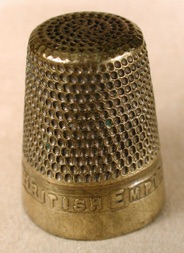
Fig 19
France
With the exception of one, the exposition thimbles that we have been able to identify from France were all 1970s re-issues by Roger Lenain of Orfèvrerie Lenain (4). All of the thimbles bear the Dé à Coudre mark (Fig 20) together with ‘France’, a size number and the Mercury head export assay mark.

Fig 20
It is likely that the original thimbles were made at the times of the expositions themselves by A Féau and that the original Lorillon/A Féau dies were purchased by Roger Lenain in 1964 when he bought ‘Le Dé à Coudre’.
Exposition Universelle (1889), Paris
The Exposition Universelle of 1889 was held in Paris during the year of the 100th anniversary of the storming of the Bastille. It was opened on the 6th May and closed on the 31st October after over 28 million visitors had passed through the gates. The main symbol of the exposition was the Eiffel Tower (Fig 21), but the ‘Galerie des machines’ was considered to be an equally significant building (Fig 22). The exposition site occupied both sides of the river Seine and covered an area of nearly a square kilometre. A major attraction at the exposition was the ‘village nègre’. Buffalo Bill and Annie Oakley performed their ‘Wild West’ show to packed audiences.

Fig 21

Fig 22
A. Féau of the Rue Portefoin in Paris exhibited at the exposition and two thimbles seem to have been made to commemorate the occasion.


Fig 23 Fig 24
They are both plain thimbles with either ‘Paris - exposition – 1889’ (Fig 23) or ‘Exposition – 1889’ (Fig 24) on the border above a round turnover rim.
Exposition Universelle (1900) Paris
The Exposition Universelle of 1900 was held on the same site, around the Eiffel Tower, as the 1889 exposition (Fig 25). It opened on the 15th April and closed on the 12th November and more than 50 million people attended the exposition during this time.

Fig 25
There were about 76,000 exhibitors and it celebrated the ‘art nouveau’ style. The Grand Palais, the Petit Palais, the Gare de Lyon, the Gare d’Orsay and the Pont Alexandre lll (Fig 26) were all built for the exposition and stand today. The World’s second Olympic games were held as part of the program.

Fig 26
A. Féau again exhibited at the exposition and on this occasion he won a gold medal for his thimbles. Two designs were produced to commemorate the exposition. They were similar to the 1889 thimbles but had ‘Paris .1900’ or ‘Exposition – 1900’ on the border (Fig 27, 28).


Fig 27 Fig 28
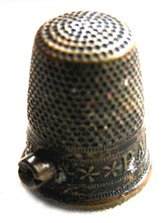
Fig 29
An inexpensive needle threading brass thimble was also produced for this exposition (Fig 29). This thimble had “Paris. 1900’ on the border.
Exposition Universelle (1914) Lyon
The Exposition Universelle of 1914 was held in Lyon, the second city of France. It was opened in May and closed in November although the start of World War l in August probably curtailed the numbers of visitors attending the exposition. The ‘Halle Tony Garnier’ dominates the site (Fig 30) and was first used for the exposition and then as a munitions factory.

Fig 30
In addition to the engineering, industrial and fine arts exhibits there were exhibits from the French Colonies in Africa and Indo-China (Fig 31). Coolies from Hong Kong manned Chinese rickshaws and the Senegalese village was a major attraction. It was hoped to distract, astonish and inform visitors with a truly ethnographic lesson but this goal was sadly interrupted by the outbreak of war.

Fig 31
A single thimble was associated with the exposition and simply bore the inscription ‘Lyon - exposition – 1914’ on the band (Fig 32).

Fig 32
Exposition Internationale des Arts et Techniques dans la Vie Moderne (1937) Paris
The Exposition Internationale des Arts et Techniques dans la Vie Moderne (International Exposition dedicated to Art and Technology in Modern Life) was held in 1937 on the Eiffel Tower site once again (Fig 33).

Fig 33
The German pavilion (Fig 34) was designed by Albert Speer and faced the Russian pavilion designed by Vera Mukhina. Both designers won gold medals and Speer was also awarder a ‘Grand Prix’ for his model of the National Party rally grounds in Nürnberg, which was on view in the German pavilion. The Civil war was in full swing in Spain and Picasso’s ‘Guernica’ was to be seen in the Spanish Pavilion.

Fig 34
Several inexpensive brass thimbles were made by the Brüder Settmacher in Vienna (Fig 35). One had a green glass top and ‘Exposition Paris 1937’ inscribed around the border. The others in either oxidized brass or yellow brass had small Parisian photographs (Arch de Triumph or Notre Dame Cathedral) with ‘Paris 1937’ overprinted applied to the border.


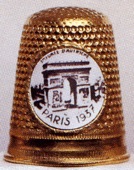
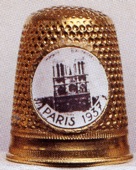
Fig 35
Germany
Fingerhüte und Historisches Nähzeug Exhibition 1978 Pforzheim
In 1978 the Schmuckmuseum in Pforzheim organized an exhibition of thimbles and sewing accessories. Pforzheim is the main centre for the goldsmith and jewellery trade in Germany and hence has a jewellery museum (5). The jewellers and smiths of Pforzheim have long been making thimbles and the museum agreed to organize an exhibition of thimbles. Thimbles were loaned by major museums, thimble makers and private collectors. The exhibition opened in the Schmuckmuseum in 1978 and then went on tour to two other museums, the Städtisches Museum in Schwäbisch Gmünd and the Goldschmiedehaus in Hanau. The Schmuckmuseum in Pforzheim commissioned three commemorative thimbles in silver gilt and gold. The silversmith was Monika Falk.



Fig 36 Fig 37 Fig 38
An Indian type thimble with moulded leafy pattern and wavy decorated rim and ‘Schmuckmuseum Pforzheim 1978’ ‘ on the border commemorated the Pforzheim exhibition (Fig 36). A plain dimpled topped (large) thimble with a grooved border and plain everted rim with "Goldschmiedehaus Hanau 1979” commemorated the Hanau exhibition (Fig 37). A plain dimpled topped thimble with a wide upper band and plain flat border imprinted with ‘Städtisches Museum * Schwäbisch Gmünd 1979’ and a plain round turnover rim commemorated the Schwäbisch Gmünd exhibition (Fig 38). Three hundred and twenty thimbles were made for Pforzheim, 110 for Hanau and 75 for Schwäbisch Gmünd (6). The early thimbles had a bare tonsure, as a result of the technique used for casting, and this was used to stamp the silver guarantee. Later thimbles had the area dimpled and the guarantee mark was stamped inside the rim (7).
It is remarkable that despite so many international expositions, which have been organized worldwide since the mid 18th century, there seem to have been relatively few thimbles made to commemorate the events. Most seem to have been made in the late 19th and early 20th centuries; possibly when the silver commemorative or souvenir thimble was at the height if popularity.
We are grateful to the Science & Society Picture Library for permission to use their image of the exhibition buildings on Cromwell Road (Fig 10) and Ray Nimmo for permission to use his picture of the oxidized brass Settmacher thimble (Fig 35).
References
1. Rogers GA. American Silver Thimbles. London: Haggerston Press, 1989.
2. Spicer N, Burn DP. British Registered Design Thimbles. 2003: pp. 5-6.
3. Spicer N. Iles- A family of thimble makers. pp. 7-8
4. Isbister M, Isbister W. The ‘’Merchant’s Warehouse’’ Fable. TCI Bulletin 2007; Spring: 1
5. Holmes EF. A history of thimbles. London: Cornwall Books, 1985. pp. 231.
6. Scholz. W-D. Correspondence. Thimble Notes and Queries, 1992;14: 17.
7. Wolber M. Correspondence. Thimble Notes and Queries, 1992;134: 16.
Diverse internet sites including:
http://en.wikipedia.org/wiki/List_of_world%27s_fairs
TCI Bulletin Summer 2010
Holmes: ‘Souvenir Thimbles’ pp. 162.
Researched and published in 2002/11
Copyright@2011. All Rights Reserved
Magdalena and William Isbister, Moosbach, Germany
exposition thimbles
Navigation
